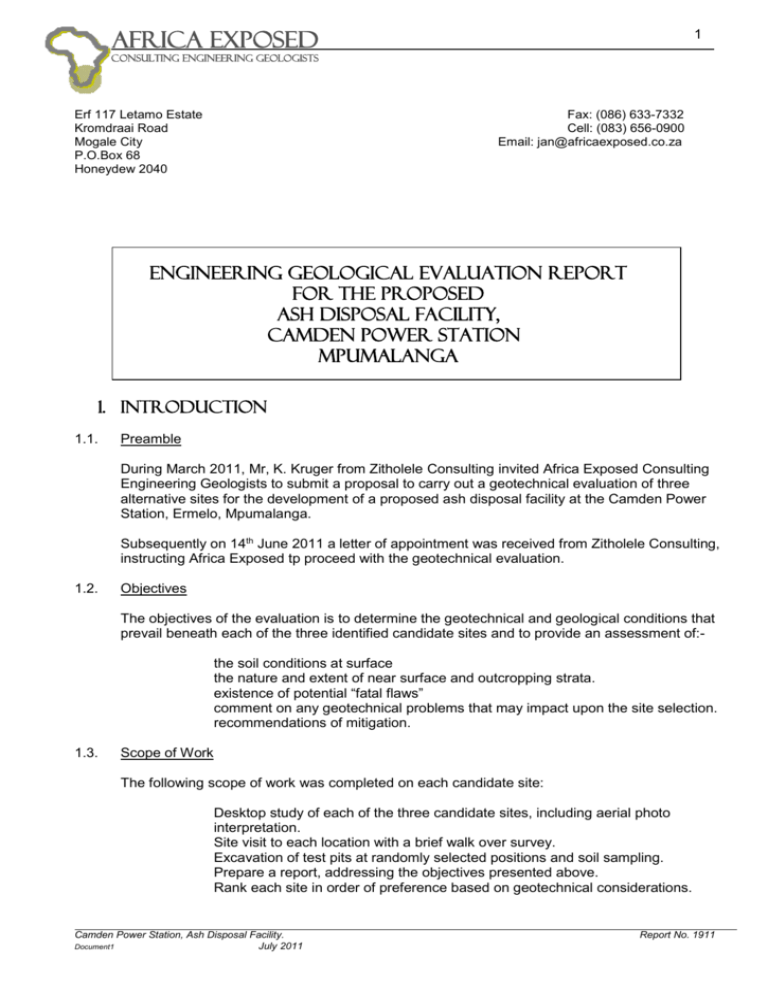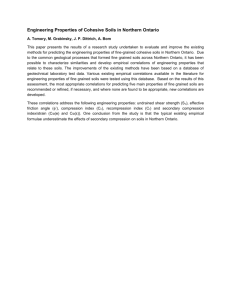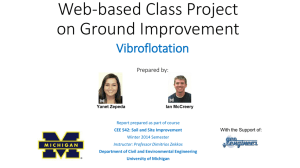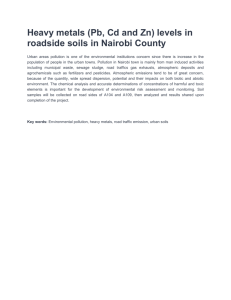africa exposed - zitholele.co.za
advertisement

AFRICA EXPOSED 1 CONSULTING ENGINEERING GEOLOGISTS Erf 117 Letamo Estate Kromdraai Road Mogale City P.O.Box 68 Honeydew 2040 Fax: (086) 633-7332 Cell: (083) 656-0900 Email: jan@africaexposed.co.za ENGINEERING GEOLOGICAL EVALUATION REPORT FOR THE PROPOSED ash disposal facility, camden power station mpumalanga 1. INTRODUCTION 1.1. Preamble During March 2011, Mr, K. Kruger from Zitholele Consulting invited Africa Exposed Consulting Engineering Geologists to submit a proposal to carry out a geotechnical evaluation of three alternative sites for the development of a proposed ash disposal facility at the Camden Power Station, Ermelo, Mpumalanga. Subsequently on 14th June 2011 a letter of appointment was received from Zitholele Consulting, instructing Africa Exposed tp proceed with the geotechnical evaluation. 1.2. Objectives The objectives of the evaluation is to determine the geotechnical and geological conditions that prevail beneath each of the three identified candidate sites and to provide an assessment of:the soil conditions at surface the nature and extent of near surface and outcropping strata. existence of potential “fatal flaws” comment on any geotechnical problems that may impact upon the site selection. recommendations of mitigation. 1.3. Scope of Work The following scope of work was completed on each candidate site: Desktop study of each of the three candidate sites, including aerial photo interpretation. Site visit to each location with a brief walk over survey. Excavation of test pits at randomly selected positions and soil sampling. Prepare a report, addressing the objectives presented above. Rank each site in order of preference based on geotechnical considerations. Camden Power Station, Ash Disposal Facility. Document1 July 2011 Report No. 1911 AFRICA EXPOSED 2 CONSULTING ENGINEERING GEOLOGISTS 2. FACTUAL REPORT 2.1 Programme of Work 2.1.1 Literary Review This geological evaluation of the sites was initially confined to a literature search and a brief site visit. Appropriate information was obtained from the following sources:i. ii. iii. iv. v. vi. vii. 2.1.2 The 1: 250 000 geological maps, No 2628 East Rand and No. 2630 Mbabane. The 1 : 50 000 topo-cadastral map 2630 CA Camden, published by The Department of Survey and Mapping, Mowbray 1985. Google Earth satellite imagery, obtainable from http/.earth.google.com. “The geology of South Africa.” edited by Johnson, M.R., Anhaeusser, C.R., and Thomas, R.J. published by the Council for Geoscience and the Geological Society of South Africa. 2006. “Engineering Geology of Southern Africa” volume 3, by A.B.A. Brink (1979), published by Building Publications. “Minimum requirements for waste disposal by landfill.” Third edition, published by the Department of Water Affairs and Forestry. 2005. “The Natural Road Construction Materials of Southern Africa” by H.H. Weinert (1980) published by Council for Scientific and Industrial Research, Pretoria. Field Work Initially a site visit was conducted on 16th May 201, where a number of potential sites were visited. Following the brief site visit three potential candidate sites were identified. On 23rd June 2011, four test pits were augered on each site and a Dynamic Cone Probe (DCP) was advanced adjacent to each test pit in order to determine the soil consistency The layout of the test pits are shown on the Site Plan in Appendix 1 and each hole was profiled by an engineering geologist according to the Jennings, Brink and Williams system, sampled as necessary and backfilled. The detailed profile logs are shown in Appendix 2. 2.1.3 Office and Laboratory Work From the soil samples recovered, six were selected for Foundation Indicator Tests and all the individual test results are included in Appendix 3 of this report. 2.2. Potential Candidate Sites The current ash disposal facility at the Camden Power station is rapidly reaching the limit of its capacity. It is therefore required that an appropriately selected alternative site is located within reasonable proximity to the power station. The ash is transported via pipelines from the power station in the form of a slurry and the site selected for the disposal facility will be developed to comply with the Minimum Requirements for Waste Disposal by Landfill, third edition of 2005 as published by Department of Water Affairs and Forestry. This proposed project is locate three potential candidate sites and to determine the geotechnical and geological suitability of each site. (see figure 1). Camden Power Station, Ash Disposal Facility. July 2011 Document1 Report No. 1911 AFRICA EXPOSED 3 CONSULTING ENGINEERING GEOLOGISTS 2.2.1. Site 1 Site 1 is located immediately north of the existing ash disposal facility and the area identified for development covers a surface area of approximately 176ha. The area is largely flat with a gentle gradient of approximately 1% down towards the west. 2.2.2. Site 2 The second site is located south of the Dejagers Pan and the main railway servitude. The site consists of three adjacent portions of ground, which combined make up a surface area of approximately 221ha. 2.2.3. Site 3 The third alternative site is located immediately south of the power station and north of the main railway servitude. This site is approximately 142ha in extent. 2.3 Site Geology From the available literature as well as the observations during the site investigation, it is apparent that all three sites are underlain by siltstone, mudstone and sandstone that belong to the Vryheid Formation of the Ecca Group, Karoo Supergroup. The presence of intruded dykes and sills in the Karoo sediments is well known and simple perusal of a 1: 250 000 scale geological maps of the area will confirm this. These features may vary in size from centimetres to tens of metres in width. Dykes and sills originate from deep seated magma chambers which force molten rock into cracks, and fissures as well as along bedding planes in the host formation. During the intrusion under the influence of extremely high pressure the host rock is further fractured in a process not to dissimilar to the proposed hydraulic fracturing. These are the reasons why water preferentially accumulates adjacent to the dykes and may provide hydraulic continuity with deeper aquifers. The geological lithologies identified on the site belong to the following stratigraphic unit: Lithology Formation Diabase intrusions Siltstone mudstone sandstone 2.3.1. Unit Post Transvaal age Vryheid formation Karoo Sequence Vryheid formation The Vryheid formation consists of coal seams, grit, sandstone, arkose and mudstone, all deposited under shallow sea conditions. A particularly significant feature of the formation is the close intercalation of the different rock types within it. It is not unusual for a lenticular body of coarse sandstone to occur within a predominantly argillaceous horizon, while a weak lens of mudstone occurring within a competent layer of sandstone is equally common. Similarly bands of rock may be laterally discontinuous and may suddenly pinch out and may reappear some distance away. Camden Power Station, Ash Disposal Facility. Document1 July 2011 Report No. 1911 AFRICA EXPOSED 4 CONSULTING ENGINEERING GEOLOGISTS Generally these rocks will decompose in-situ, forming residual soils that may be silty and clayey, with the possibility of expansive soil being present. These soils are often blanketed by a considerable thickness of transported soils of colluvial origin that consist of silty and clayey fine sands. 2.3.2. Diabase Sills and Dykes The eastern portion of Area 3 is underlain by a dolerite sill and the contact between the intruded igneous rock and the host sedimentary formations is orientated approximately southwest to northeast through the center of the site. Due to the emplacement of the igneous material the contact zone is typically fractured and differential weathering of the rock may result in deep residual soils occurring along the boundary. Limited surface exposures of dolerite are usually noted and the presence of the intrusive features are alluded to by the accumulation of well rounded igneous boulders at ground surface. 2.4 2.4.1 Hydrology Surface Drainage The average annual rainfall in this area is approximately 750mm, most of which occurs as heavy, isolated thunder showers between October and March. Storm water runoff is generally in the form of sheetwash, which flows towards the nearest local drainage course and the adjacent Vaal river. 2.4.2 Perched Ground Water No groundwater seepage was encountered in the test pits and therefore the depth of the perched water table could not be determined. It was immediately evident from the aerial photographs and the site visit that localised areas particularly in the vicinity of standing surface water are subject to seasonal seepage. The shallow perched water levels which often give rise to seepages on surface are usually in response to intense rainfall events, and this is not a sustainable source of ground water and is very dependant on rainfall. Further evidence of the presence of a seasonal perched water table is the almost ubiquitous horizon of ferruginised soil, consisting of ferricrete nodules in a matrix of clayey and silty sand that is indicative of pedogenisis. Ferricrete forms by the relative accumulation of sesquioxides (Fe2O3) by the removal of the more soluble constituents of the soil, which occurs under conditions of seasonal saturation. The iron is mobilised under reducing conditions in the wet season and precipitated under oxidising conditions experienced in the dry season, thereby giving rise to the ferruginised soil horizons that generally occur within 1.0 to 2.0m of the surface. Camden Power Station, Ash Disposal Facility. Document1 July 2011 Report No. 1911 AFRICA EXPOSED 5 CONSULTING ENGINEERING GEOLOGISTS 2.4.3. Permanent Ground Water The potentially deeply weathered sandstone and siltstone in the area will decompose to form residual soils with a clay-silt and sand texture and may extend to depths of up to 20m. As alluded to in 2.3.1 above the sedimentary rocks of the Vryheid formation are highly variable both horizontally and vertically. The sandstone which occur in the area are generally coarsely bedded and fractured and are also closely jointed, and it is within the structural fabric of the rock that a secondary aquifer of limited extent will be developed. These aquifers are usually restricted by the depth of weathering, the presence of aquatards, such as intruded dykes and the thickness of the geological formation. (see figure 2 below). It is anticipated the phreatic surface will be encountered at a depth of approximately 20 to 30m (see figure 3 below). Figure 3. Different modes of weathering exhibited by different types of rock. Siltstone (A) weathers easily with a gradual transition to regolith, and is generally not exposed at surface. Sandstone (B and C) is more resistant, but joint weathering has broken the formation into residual blocks. The formation is likely to outcrop at surface or immediately beneath a thin mantle of transported soils. The secondary aquifer will be confined within the fractured and jointed rock usually within 30m of the surface . (taken from “Introduction to Groundwater” GSSA, Ground Water Division 1992) Due to the low permeability of the soils as well as the high degree of variability in the weathering of the sandstone and siltstone formations, particularly in the vicinity of Camden Power Station, groundwater yields will vary from borehole to borehole over even short distance and yields are typically poor (0.5-2.0l/s). 2.5 Observations Twelve test pits were excavated to an average depth of 1.4m and medium hard excavation conditions were experienced in each hole. A summary of the prevailing soils is presented below, while the detailed soil profiles are included in Appendix 2. Camden Power Station, Ash Disposal Facility. Document1 July 2011 Report No. 1911 AFRICA EXPOSED 6 CONSULTING ENGINEERING GEOLOGISTS 2.5.1. Transported Materials The entire area is covered by transported soil which may vary in thickness from a few centimetres up to several metres. Due to the transported origin of the soils the geotechnical characteristics are typically highly variable and difficult to predict. The transported soils that occur on the lower slopes of the undulating topography are described as silty sand and gravels, of colluvial (hillwash) origin. The soils are generally of loose to medium dense consistency, and is rich in organic matter. The base of the transported soils is defined by the pebble marker which consists of a thin horizon (usually 20 to 40cm thick) that contains sub-rounded and angular quartz gravels, in a matrix of greyish brown silty sand. 2.5.2 Alluvium Within the low lying portions along the western side of Area 2 and the eastern side of Area 1 that are occupied small non-perennial streams that flow towards the northeast, areas of recently deposited alluvial sediments occur. These soils are derived from the proximal rocks that occur in the area and the soil texture and mechanical properties are characterised by the lithologies from which they are derived. Typically the soils will be characterised by unconsolidated sediments that consist of sandy silt and clay with a high organic content. The thickness of these soils will vary considerably, and it must be anticipated that the soils may be potentially expansive as well as highly compressible. 2.5.3. Pedogenic Soils The base of the transported soils is usually defined by the pebble marker that has been subjected to pedogenesis in places. The degree of cementation of the pedogenic material varies from scattered ferricrete nodules, honeycomb ferricrete to hardpan ferricrete. The consistency of the horizon is dependant on the degree pedogenisis, varying from dense to very soft rock consistency and is approximately from 0.3 to 0.5m thick. 2.5.4. Residual soils A brief description of the residual soils derived from each of the geological formations is also presented. 2.5.4.1 Diabase Intrusions. The post Transvaal age dolerite intrusions that occur in the area generally consists of completely weathered, coarse grained, closely jointed, medium hard rock, diabase. In the sub humid and humid warm climatic regions of the country, falling within the Wienert’s climatic N value of less than 5 (Ermelo has a value of 1.8) such as the area investigated, the dolerite undergoes chemical decomposition, which produces residual soils which are commonly expansive. A particularly interesting feature about the dolerite sills in the eastern parts of South Africa is the extreme variability in the depth and degree of decomposition over a relatively short distance. Within a few meters of an outcrop of solid rock a test pit may disclose a substantial depth of decomposition. Camden Power Station, Ash Disposal Facility. Document1 July 2011 Report No. 1911 AFRICA EXPOSED 7 CONSULTING ENGINEERING GEOLOGISTS 2.5.4.2 Vryheid formation The residual soils derived from the Vryheid formation weather to form stiff, fine grained sandy silt and clayey silt that may be weathered to depths of up to 20m . Typically the residual soils are 2 to 4m in thickness, grading into very soft rock siltstone or sandstone. It is common that the residual siltstone and mudstone contain a high proportion of montmorillonite clays and lesser amounts of kaolinite, mica and quartz, which imply that these soils may be highly expansive. 2.6 Laboratory and Field Test Results For more accurate identification and classification purposes, Particle Size Distribution and Atterberg Limits Tests were carried out on representative samples of the various soil horizons present within the site. The results are shown in Appendix 3 of this report and are summarised in Table 1 below. TABLE 1. TP No. Depth (m) 1 1.0-1.1 2 3. Summary of Indicator test results Material PI PI (ws) LS (%) Activity Silty sand and ferricrete. Ferruginised hillwash. 24 20 12 med 1.4-1.5 Silty clayey sand and ferricrete. Rew. Res. Siltstone 18 16 8 med 5 1.4-1.5 Silty sandy clay and gravel. Rew. Res. Siltstone 23 19 10 med 7 1.3-1.4 Silty clayey sand. Hillwash 15 10 7 low/med 9 1.1-1.2 Gravel and ferricrete with silty sand. Ferruginised Res. Siltstone 16 12 7 med 11 1.1-1.3 Silty clayey sand. Hillwash 16 8 7 low INTERPRETIVE REPORT 3.1. Impact Assessment The methodology employed to determine the environmental impact of the geotechnical aspects of the proposed project, were included in the Zitholele Consulting letter of appointment, dated 14 June 2011. In summary the method makes provision for the assessment of the impacts against the following criteria: significance spatial scale temporal scale degree of certainty These impacts are assessed in both a qualitative and quantitative method. Camden Power Station, Ash Disposal Facility. Document1 July 2011 Report No. 1911 AFRICA EXPOSED 9 CONSULTING ENGINEERING GEOLOGISTS Each candidate site was evaluated in terms of the recommendations of Section 4, Site Selection of the Minimum Requirements for Waste Disposal by Landfill (2005) document, and from a geotechnical and geohydrological perspective the following situations are considered to constitute a fatal flaw. Area below the 1 in 100 year flood line. Area in close proximity to significant water bodies. Unstable areas. Areas characterised by flat gradients, shallow or emergent ground water. Area characterised by steep gradients where stability of slopes could be problematic. Areas of ground water recharge on account of topography and or highly permeable soils. Areas characterised by shallow bedrock with little soil cover. Utilising the evaluation criteria listed above the impact of the proposed land use was determined. 3.1.1 Site 1 i. ii. iii. iv. v. vi. vii. viii. This site is located immediately north of the existing ash disposal facility, and approximately 2.8km northwest of the Camden power station. The size of the area is approximately 176ha. The area is situated on a relatively flat portion of ground that has a gentle gradient down towards the west at 1 to 2%. The site is currently un used for any other activities and the vegetation consists of typical Highveld grasslands. The entire site appears to be underlain by inter bedded sandstone and siltstone of the Vryheid formation. No evidence of the presence of intruded sills or dykes were identified. The Camden village is located approximately 300m to the east of the site. No ground water seepage was observed on the site and no seepage was recorded in the test pits. A drainage course that directs runoff from the existing ash disposal facility is located on the eastern side of the site, while the Dejagers pan is located within 500m to the south of the site. The underlying soils on the site consist of a shallow horizon of transported soils to an approximate depth of 500mm, which overly ferruginised, jointed reworked residual siltstone. The depth of weathering is anticipated to extend to a depth of approximately 3 to 5m. Camden Power Station, Ash Disposal Facility. Document1 July 2011 Report No. 1911 AFRICA EXPOSED 10 CONSULTING ENGINEERING GEOLOGISTS The determined impact assessment is shown in table 2 below. TABLE 2. Impact assessment of Site 1 Criteria Significance Spacial Scale Temporal Scale Probability Within 1 in 100 year flood line NO IMPACT Proposed site Incidental Unlikely 0 1 1 2 Proximity to significant water body LOW Study Area Long term Could happen 2 2 4 3 Unstable area VERY LOW Proposed site Incidental Practically Impossible 1 1 1 1 Flat gradient and emergent ground water LOW Study Area Incidental Could happen 2 2 1 3 Steep gradient and slope stability problems NO IMPACT Proposed site Incidental Practically Impossible 0 1 1 1 Area of groundwater recharge LOW Local Long term Unlikely 2 3 4 2 Shallow bedrock and poor soil cover LOW Study Area Permanent Very likely 2 2 5 4 3.1.2 Rating 0.3 1.6 0.2 1 0.3 1.2 2.4 Site 2 i. ii. iii. iv. v. vi. vii. viii. This site is located immediately south of Dejagers Pan and the railway servitude, approximately 3.0km southwest of the Camden power station. The total area potentially available for development is approximately 221ha, of which it is considered that the eastern portion covering a surface area of some 98ha is the most suitable area. The area is situated on a shallow sloping site with a gradient down towards the north of 3 to 4% and the site is currently used for agricultural activity. The entire site appears to be underlain by inter bedded sandstone and siltstone of the Vryheid formation. No evidence of the presence of intruded sills or dykes were identified. An electrified dual railway line is located immediately north of the proposed site and a powerline servitude is located along the eastern side. No ground water seepage was observed on the site and no seepage was recorded in the test pits, however it is likely that the area may be subjected to seasonal seepage. The eastern side of the site partially encroaches into drainage course of a small northeasterly flowing non-perennial stream. The Dejagers pan is located within 1.2km to the northwest of the site. The underlying soils on the site consist of a shallow horizon of transported soils to an approximate depth of 500 to 10000mm, which overly ferruginised, jointed reworked residual siltstone. The depth of weathering is anticipated to extend to a depth of approximately 3 to 5m. Camden Power Station, Ash Disposal Facility. Document1 July 2011 Report No. 1911 AFRICA EXPOSED 11 CONSULTING ENGINEERING GEOLOGISTS The determined impact assessment is shown in table 3 below. TABLE 3. Impact assessment Site 2 Criteria Significance Spacial Scale Temporal Scale Probability Within 1 in 100 year flood line LOW Local Incidental Unlikely 2 3 1 2 Proximity to significant water body LOW Study Area Long term Could happen 2 2 4 3 Unstable area VERY LOW Proposed site Incidental Practically Impossible 1 1 1 1 Flat gradient and emergent ground water VERY LOW Study Area Incidental Could happen 1 2 1 3 Steep gradient and slope stability problems NO IMPACT Proposed site Incidental Practically Impossible 0 1 1 1 Area of groundwater recharge MODERATE Local Long term Could happen 3 3 4 3 Shallow bedrock and poor soil cover LOW Study Area Permanent Very likely 2 2 5 4 3.1.3 Rating 0.8 1.6 0.2 0.8 0.1 2 2.4 Site 3 i. This site is located approximately 1.2km directly south of the Camden Power Station and immediately north of the SAR railway servitude. ii. The total area potentially available for development is approximately 142ha. iii. The area is situated within the headwaters of a non-perennial north flowing stream that flows into the Witpuntspruit some 3km to the northeast. The general slope of the site is approximately 1% down towards the northeast and the site is currently undeveloped. iv. On the basis of the geological information available it is apparent that the site straddles the contact between the host sedimentary formations on the western side and an intruded dolerite sill to the east. The contact between the two geological lithologies is approximately along the non perennial stream mentioned in paragraph iii above. Due to the emplacement of the igneous material the contact zone is typically fractured and differential weathering of the rock may result in deep residual soils occurring along the boundary. v. An electrified dual railway line is located immediately south of the proposed site and the coal stockpile and water storage facilities are located to the north and northwest of the area. vi. Shallow ground water seepage was observed on the northern portion of the site and due to the topographic setting it must be anticipated that significant seepage and surface runoff will be encountered during periods of high rainfall. Camden Power Station, Ash Disposal Facility. Document1 July 2011 Report No. 1911 AFRICA EXPOSED 12 CONSULTING ENGINEERING GEOLOGISTS vii. The underlying soils on the site consist of a shallow horizon of transported silty and clayey soils to an approximate depth of 500 to 10000mm, which overly ferruginised, jointed reworked residual siltstone. The depth of weathering is anticipated to extend to a depth of approximately 3 to 5m. TABLE 4. Impact assessment Site 3 Criteria Significance Spacial Scale Temporal Scale Probability Within 1 in 100 year flood line HIGH Regional long term Very likely 4 4 4 4 Proximity to significant water body LOW Study Area Long term Could happen 2 2 4 3 Unstable area VERY LOW Proposed site Incidental Practically Impossible 1 1 1 1 Flat gradient and emergent ground water VERY LOW Local Long term Could happen 4 3 4 3 Steep gradient and slope stability problems NO IMPACT Proposed site Incidental Practically Impossible 0 1 1 1 Area of groundwater recharge MODERATE Local Long term Could happen 3 3 4 3 Shallow bedrock and poor soil cover LOW Study Area Permanent Very likely 2 2 5 4 Rating 4.8 1.6 0.2 4.6 0.1 2 2.4 3.2. Recommendations On the basis of this evaluation it is apparent that site 3 is not suitable for the intended development, and should not be considered for further investigation. The remaining two target sites, namely Site 1 and Site 2 are both considered to be suitable for further consideration. From a geological and geotechnical perspective it is considered that site 1 is the preferred option, however more detailed geotechnical and hydrogeological investigations will be required on both sites AFRICA EXPOSED CONSULTING ENGINEERING GEOLOGISTS J.K.A. ARKERT Pr.Sci.Nat. AFRICA EXPOSED 13 CONSULTING ENGINEERING GEOLOGISTS REFERENCES 1. Brink A.B.A “Engineering Geology of Southern Africa” volume 1 and 3, published by Building Publications. 1979. 2. Fernandez L.M. and Guzman J.A. “Earthquake hazard in southern Africa.” - Seismological Series 10. Geological Survey, 1979. 3. Geological Survey of RSA, “Seismic Hazard Maps For Southern Africa” Pretoria, 1992. 4. Jennings J.E. and Knight K. “A guide to construction on or with materials exhibiting additional settlement due to collapse of grain structure.” - Proceedings of the 6th Regional Conference for Africa on Soil Mechanics and Foundation Engineering. Durban. 1975. 5. Jennings JE et al . "Revised Guide to Soil profiling for Civil Engineering Purposes in Southern Africa" - Civil Engineer in South Africa , January 1973 6. Johnson, M.R, Anhauesser, C.R. and Thomas, R.T, “The geology of South Africa” by published by Geological Society of South Africa in 2006. 7. Van der Merwe DH . "The prediction of heave from the Plasticity Index and percentage clay fraction of soils" - Civil Engineer in South Africa Vol 6, 1964. 8. Wilson,M.G.C and Anhaeusser, C.R. “The Mineral Resources of South Africa.” Handbook 16, Sixth Edition. Council For Geoscience 1998. 9. Weinert H.H. “The Natural road construction materials of South Africa.” - Academica (Cape Town), 1980. ` Camden Power Station, Ash Disposal Facility. Document1 July 2011 Report No. 1911







